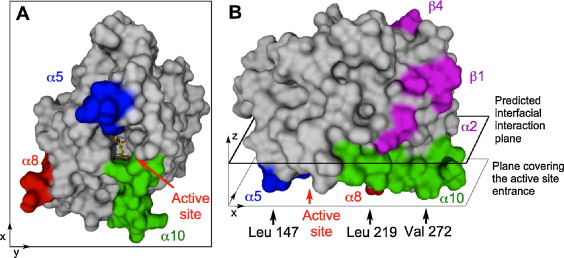Sandbox christian
From Proteopedia
Dynamic properties of Candida antarctica lipase B at hydrophobic interfaces
Lipase B from Candida antarctica binds to hydrophobic substrate–water interfaces via hydrophobic anchors surrounding the active site entrance [1],[2],[3].
Abstract: Candida antarctica Lipase B (CALB) has been extensively studied over the past decades and has proved to be an efficient catalyst for various industrial and scientific applications. Because of its ability to hydrolyse soluble and insoluble substrates and the lack of a classical interfacial activation it was previously characterized as an intermediate between a lipase and an esterase. We show by molecular dynamics simulation in full atomistic detail that CALB attaches and binds to a hydrophobic tributyrin–water interface via three hydrophobic anchor regions defined by Leu 147, Leu 219, and Val 272 surrounding the entrance to the active site. These regions trigger the reorientation of the protein via hydrophobic interactions even when the protein impacts at the surface in a non-optimal orientation. During the binding process the flexible helix α5 undergoes a movement of 7.5 Å towards the substrate layer. Though tributyrin has no net charge a long-range attraction between interface and protein was observed up to a separation of 7 Å that corresponds to the amplitude of the fluctuations of the tributyrin surface. A stable binding of the protein with the active site oriented towards the active site was observed for several hundreds of nanoseconds in total. During that time, single tributyrin molecules moved from the into the substrate binding site of CALB and were temporarily binding as productive sn3-complexes.

(A) Hydrophobic regions of CALB: anchor residues are located in helix α5 (blue), α 8 (red) and α 10 (green) surrounding the entrance to the active site ( shown as yellow sticks). (B) The outermost hydrophobic residues Leu 147, Leu 219, and Val 272 define the (thin line). The interfacial interaction plane predicted by the “Orientations of Proteins in Membranes” (OPM) database is parallel to this x/y plane (thick line).
| |||||||||||
- ↑ C. Gruber, J. Pleiss: Lipase B from Candida antarctica binds to hydrophobic substrate-water interfaces via hydrophobic anchors surrounding the active site entrance, J MOL CATAL B-ENZYM, 2012; http://dx.doi.org/10.1016/j.molcatb.2012.05.012
- ↑ Gruber CC, Pleiss J. Molecular modeling of lipase binding to a substrate-water interface. Methods Mol Biol. 2012;861:313-27. PMID:22426727 doi:10.1007/978-1-61779-600-5_19
- ↑ Gruber CC, Pleiss J. Systematic benchmarking of large molecular dynamics simulations employing GROMACS on massive multiprocessing facilities. J Comput Chem. 2011 Mar;32(4):600-6. doi: 10.1002/jcc.21645. Epub 2010 Sep 1. PMID:20812321 doi:10.1002/jcc.21645
